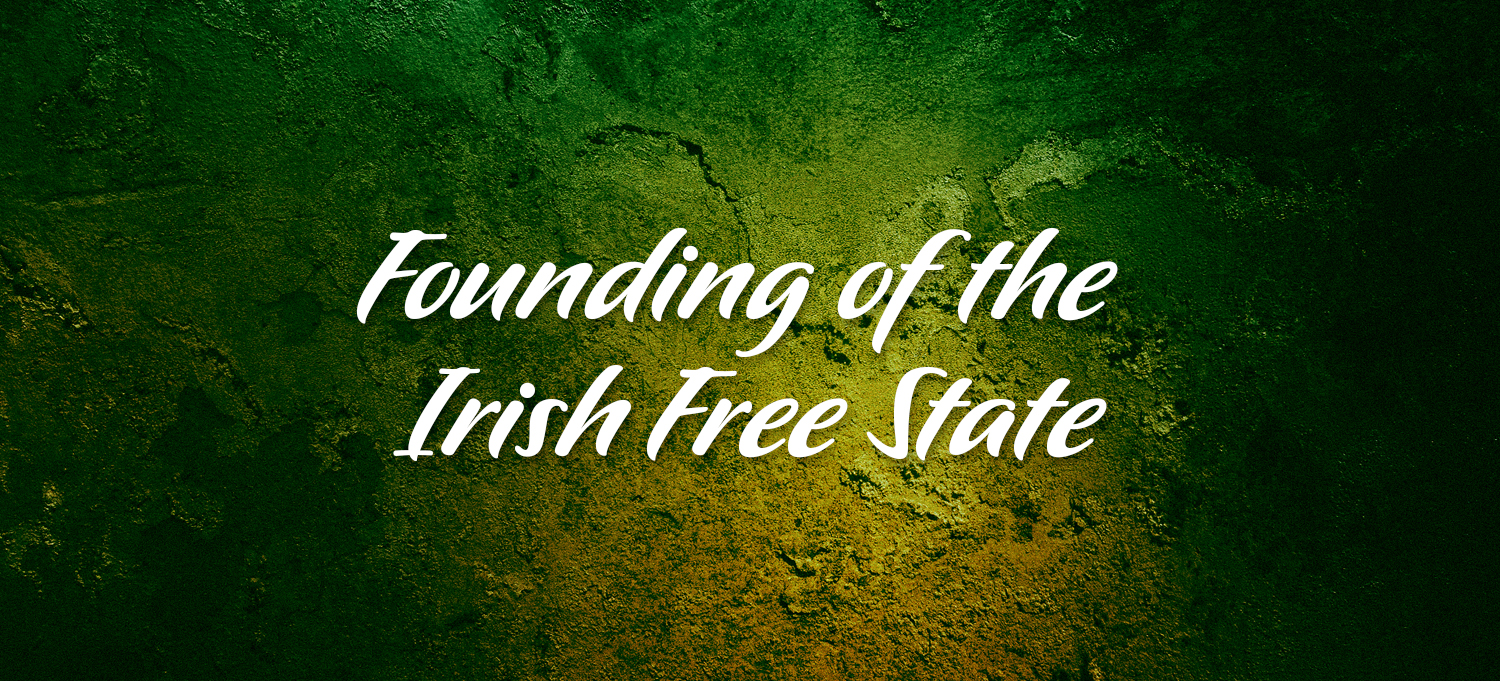
Founding of the Irish Free State
On January 7, 1922, the Dáil passed the Anglo-Irish Treaty by a vote of 64 to 57. As a result Saorstát Éireann, the Irish Free State, was born. International recognition of Irish independence would not come until the formal creation of the Irish Free State on December 6th 1922, but Ireland would not officially become a republic until midnight on Easter Sunday, April 17th 1949.
Under the Anglo-Irish Treaty signed in December 1921, 26 of Ireland’s 32 counties became autonomous within the British empire, in the form of the Irish Free State. Ireland had reluctantly became a partitioned dominion within the British empire, with the British monarch as its official head of state.
This note, hastily written by Arthur Griffith, was the first message to the public on the outcome of the negotiations which led to the Anglo-Irish Treaty of 1921. Written for issue to the World Press immediately after signing the Treaty on 6 December, it reads:
“I have signed a Treaty of peace between Ireland and Great Britain. I believe that treaty will lay foundations of peace and friendship between the two Nations. What I have signed I shall stand by in the belief that the end of the conflict of centuries is at hand”.
Details of the Anglo Irish Treaty
Once a truce had been called in July 1921 a series of meetings were held between the two sides with the Irish delegation led by Arthur Griffith and including Michael Collins carrying out the negotiations with the British government. After two months an agreement was reached, officially known as The Articles of Agreement for a Treaty between Great Britain and Ireland.
The Treaty would see the withdrawal of British troops from the majority of the country, but gave dominion status to Ireland rather than that of an independent Republic, retained the Oath of Allegiance to the British Crown, and provided for the establishment of a Boundary Commission to create a border between the Irish Free State and the Northern counties which opted to remain under British rule.
The Irish negotiators; Griffith, Collins, Robert Barton, Eamonn Duggan and George Gavan Duffy, though not happy with the terms, were told by Lloyd George that non-acceptance would lead to a resumption of the war which, at the point the Truce was called, was being lost by the IRA. The delegation eventually recommended the Treaty to Dáil Éireann, and it was signed on the 6 December 1921.
The Treaty was rejected by de Valera and split Republican opinion. Though it was narrowly ratified in the Dáil. The terms of the Treaty were a far cry from the republic demanded by the independence movement and the split over Ireland’s new constitutional status was the principal cause of the Civil War of 1922-23.
Read more on the Civil War Here
Governmental and Constitutional Structures of the Irish Free State
The Treaty established that the new Irish Free State would be a constitutional monarchy, with the Governor-General of the Irish Free State as representative of the Crown. The Constitution of the Irish Free State made more detailed provision for the state’s system of government, with a three-tier parliament, called the Oireachtas, made up of the King and two houses, Dáil Éireann and Seanad Éireann (the Irish Senate). Executive authority was vested in the King, with the Governor-General as his representative. He appointed a cabinet called the Executive Council to “aid and advise” him. The Executive Council was presided over by a prime minister called the President of the Executive Council. In practice, most of the real power was exercised by the Executive Council, as the Governor-General was almost always bound to act on the advice of the Executive Council. The office of Governor-General of the Irish Free State replaced the previous Lord Lieutenant, who had headed English and British administrations in Ireland since the Middle Ages. Governors-General were appointed by the King initially on the advice of the British Government, but with the consent of the Irish Government. Tim Healy held the position of Governor General from 6 December 1922 until 31 January 1928, having been appointed by King George V. From 1927 the Irish Government alone had the power to advise the King whom to appoint.
Oath of Allegiance
As with all dominions, provision was made for an Oath of Allegiance. Within dominions, such oaths were taken by parliamentarians personally towards the monarch. The Irish Oath of Allegiance was fundamentally different. It had two elements; the first, an oath to the Free State, as by law established, the second part a promise of fidelity, to His Majesty, King George V, his heirs and successors. That second fidelity element, however, was qualified in two ways. It was to the King in Ireland, not specifically to the King of the United Kingdom. Secondly, it was to the King explicitly in his role as part of the Treaty settlement, not in terms of pre-1922 British rule. The Oath itself came from a combination of three sources, and was largely the work of Michael Collins in the Treaty negotiations. It came in part from a draft oath suggested prior to the negotiations by President de Valera. Other sections were taken by Collins directly from the Oath of the Irish Republican Brotherhood (IRB), of which he was the secret head. In its structure, it was also partially based on the form and structure used for ‘Dominion status’.
Although ‘a new departure’, and notably indirect in its reference to the monarchy, it was criticised by nationalists and republicans for making any reference to the Crown, the claim being that it was a direct oath to the Crown, a fact demonstrably incorrect by an examination of its wording, but in 1922 Ireland and beyond, it was the perception, not the reality, that influenced public debate on the issue. Had its original author, Michael Collins, survived, he might have been able to clarify its actual meaning, but with his assassination in August 1922, no major negotiator to the Oath’s creation on the Irish side was still alive, available or pro-Treaty (the leader of the Irish delegation, Arthur Griffith, had also died in August 1922). The Oath was also a key issue in the resulting Irish Civil War that divided the pro and anti-treaty sides.
Text of the Oath of Allegiance
“I (name) do solemnly swear true faith and allegiance to the Constitution of the Irish Free State as by law established, and that I will be faithful to H.M. King George V, his heirs and successors by law in virtue of the common citizenship of Ireland with Great Britain and her adherence to and membership of the group of nations forming the British Commonwealth of Nations”.
Successes and Challenges for the Free State Government
During the 1920s, the Cumann na nGaedheal government led by W.T. Cosgrave sought opportunities to amplify the newly-official international status of the Irish Free State while at the same time diminishing its ties to the empire. Ireland’s participation in the League of Nations was shaped, to some degree, by the desire to carve out an international niche distinct from the sphere of British influence. In the late 1920s, Irish ministers and diplomats played a major role in laying the groundwork for the 1926 Balfour Declaration, which gave all dominions the same international status as Britain, and the 1931 Statute of Westminster, which specified that the domestic sovereignty of individual dominions took precedence over that exercised by Westminster.
Key Events of the 1920’s in Ireland
8 August 1923: The Garda Siochana, an unarmed police force, is established by law.
3 December 1925: The Boundary Commission promised under the terms of the Treaty is shelved and the existing border remains intact in exchange for a cancellation of certain debts to the British government. President Cosgrave in a press statement says, “The cloud of division between North and South which has hung over the country for the last fifty years has begun to lift.”
1 January 1926: Radio 2RN, the national broadcasting station opens.
10 July 10 1927: Kevin O’Higgins vice-president of the Executive Council and Minister for Justice, is shot dead by republicans outside his home in Booterstown. The Government responds with a Bill requiring future Dail candidates to sign an affidavit that they will take the oath if elected.
7 May 1928: The voting age for women is lowered from 30 to 21.
14 October 1928: Dublin’s Gate Theatre opens at the Peacock with Peer Gynt.
29 July 1929: Official opening of Ardnacrusha hydroelectric station in Clare.
WOMEN’S VOICES HOME | PART I | PART II | PART III | PART IV | BIOS | ARTISTS

